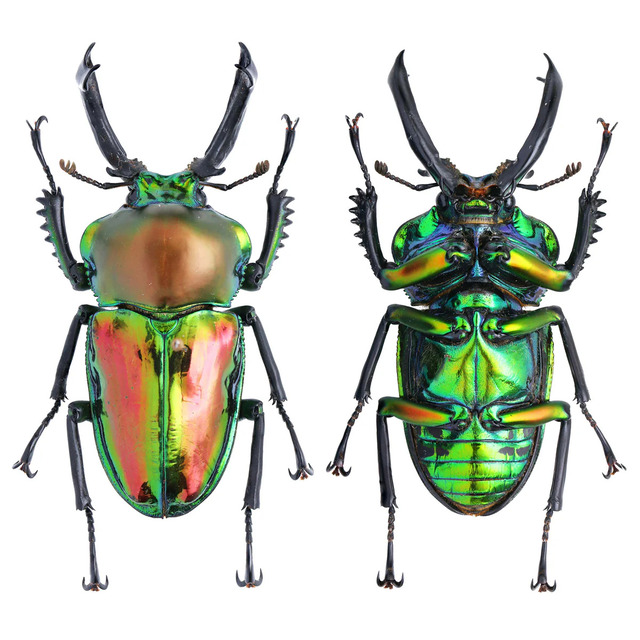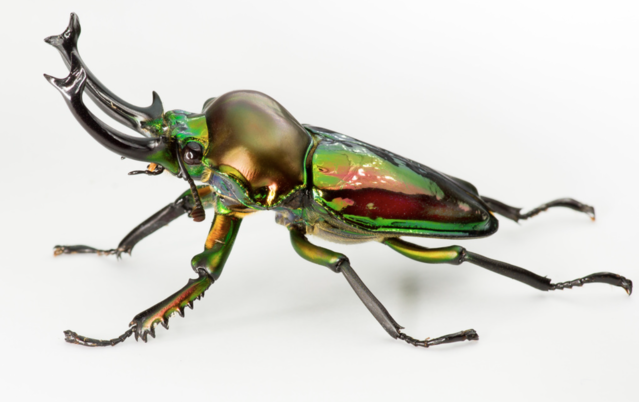Phalacrognathus muelleri, colloquially known as the rainbow stag beetle, and alsothe king, magnificent or Mueller's stag beetle, is a striking and highly admired insect from the Lucanidae family. With its brilliant metallic sheen and unique body features, it has become one of the most iconic stag beetles in the world. Found primarily in Queensland, Australia, and parts of New Guinea, this species is known for its impressive size, stunning coloration, and its important ecological role in forest ecosystems.
This article will explore the distinct characteristics, habitat, diet, life cycle, and conservation status of Phalacrognathus muelleri. Additionally, it will delve into its importance in entomology, its rising popularity in the insect collecting community, and the need for conservation efforts.
Taxonomy
Animalia
Phylum Arthropoda
Subphylum Hexapoda
Insecta
Subclass Pterygota
Coleoptera
Suborder Polyphaga
Scarabaeiformia
Scarabaeoidea
Lucanidae
Subfamily Lampriminae
Genus Phalacrognathus
Rainbow stag beetle Phalacrognathus muelleri

Phalacrognathus muelleri is known for its vibrant metallic color, which can range from green, blue, purple, red, and golden hues, creating a mesmerizing effect under sunlight. This species is renowned for its structural coloration, where microstructures on its exoskeleton reflect light to produce a rainbow-like sheen. This makes it an extraordinary example of biological iridescence.
Size: Male Rainbow Stag Beetles can grow up to 70 millimeters (2.8 inches) in length, while females are usually smaller, measuring around 40 millimeters (1.6 inches).
Distinctive Horns: Males possess large, curved horns that resemble antlers, which are used primarily for fighting with other males during the mating season. These horns can reach impressive sizes, which is characteristic of the stag beetle family.
Sexual Dimorphism: One of the most notable features of this species is its sexual dimorphism. Males are much larger and more ornamented than females, with their antler-like mandibles being a defining characteristic. In contrast, females have smaller, less-developed mandibles.
Phalacrognathus muelleri is native to tropical forests in northeastern Australia (specifically Queensland) and parts of New Guinea. These regions provide a warm, humid environment with abundant decaying wood, tree sap, and fruits, which are essential for their diet and lifecycle.
The beetle is primarily found in rainforests, where it thrives in rotting tree trunks and decaying organic matter, which provide food and shelter for both adults and larvae. It also prefers areas with abundant eucalyptus trees and other hardwood species, which offer rich sources of sap and decaying material for feeding.
As with many other stag beetles, Phalacrognathus muelleri is a sap-feeding beetle. Adults feed primarily on tree sap, rotting fruits, and fermented liquids. Their strong, specialized mouthparts are adapted to accessing the sap from decaying tree trunks or feeding on fallen fruit.
Adults: They prefer tree sap produced by certain hardwoods, particularly eucalyptus, which is abundant in their native habitats. They are also known to consume overripe fruits, which are rich in sugar and attract them.
Larvae: The larvae of Phalacrognathus muelleri feed on decaying wood, especially the soft interior of rotting tree trunks. This diet is essential for their growth and development into adult beetles.
Phalacrognathus muelleri follows a typical stag beetle life cycle, which includes four main stages: egg, larva, pupa, and adult.
Egg Stage: Female beetles lay their eggs in decaying wood. Each female can lay dozens of eggs, which hatch into larvae after about 2-3 weeks.
Larval Stage: The larvae feed on decaying wood, which provides them with nutrients. This stage can last up to one year, depending on environmental conditions and food availability. They develop large bodies during this time and can grow up to 80 millimeters (3 inches) in length.
Pupal Stage: After the larvae reach full size, they enter the pupal stage, where they undergo metamorphosis to become adults. The pupal stage can last anywhere from one to two months.
Adult Stage: Once the adult emerges, it begins to feed on sap and rotting fruit. Adult Rainbow Stag Beetles are highly active during the wet season, which coincides with their breeding period. Males engage in fierce battles to defend territories and attract females.

Phalacrognathus muelleri plays a crucial role in its native ecosystem. As a sap feeder, it helps in the decomposition process by feeding on decaying organic matter, which recycles nutrients back into the soil. This contributes to forest health and ensures the continuous nutrient cycling in the ecosystem.
Additionally, the larvae of Phalacrognathus muelleri contribute to the breakdown of decaying wood, accelerating the decomposition process and promoting forest regeneration. These beetles also serve as prey for various predators, including birds and small mammals, maintaining balance in the food chain.
Currently, Phalacrognathus muelleri is not listed as endangered or threatened. However, like many tropical species, it is vulnerable to habitat destruction caused by deforestation and climate change. The destruction of their rainforest habitat, especially the clearing of trees for agriculture and urban development, poses a significant threat to their populations.
Additionally, the illegal insect trade and collection for ornamental purposes have led to population declines in some areas, highlighting the need for better conservation efforts and awareness.
Phalacrognathus muelleri is an incredibly popular species in the entomology community due to its unique coloration and impressive size. It has become a prized specimen for collectors worldwide. Captive breeding programs have been established to help conserve this species and make it accessible to enthusiasts without depleting wild populations.
Phalacrognathus muelleri, the Rainbow Stag Beetle, is an extraordinary and colorful insect that plays a vital role in its native tropical ecosystems. Its distinctive features, impressive size, and biological iridescence make it a standout species in the beetle world. Despite its popularity in the pet trade, it faces potential threats from deforestation and climate change, making conservation efforts crucial to its long-term survival.
For those interested in entomology, insect collecting, or conservation, Phalacrognathus muelleri represents both a fascinating study subject and a symbol of the delicate balance required to maintain biodiversity in our forests.
animal tags: Lucanidae
We created this article in conjunction with AI technology, then made sure it was fact-checked and edited by a Animals Top editor.